Processing of DNA for nonhomologous end-joining by cell-free extract
- PMID: 15692565
- PMCID: PMC549622
- DOI: 10.1038/sj.emboj.7600563
Processing of DNA for nonhomologous end-joining by cell-free extract
Abstract
In mammalian cells, nonhomologous end-joining (NHEJ) repairs DNA double-strand breaks created by ionizing radiation and V(D)J recombination. We have developed a cell-free system capable of processing and joining noncompatible DNA ends. The system had key features of NHEJ in vivo, including dependence on Ku, DNA-PKcs, and XRCC4/Ligase4. The NHEJ reaction had striking properties. Processing of noncompatible ends involved polymerase and nuclease activities that often stabilized the alignment of opposing ends by base pairing. To achieve this, polymerase activity efficiently synthesized DNA across discontinuities in the template strand, and nuclease activity removed a limited number of nucleotides back to regions of microhomology. Processing was suppressed for DNA ends that could be ligated directly, biasing the reaction to preserve DNA sequence and maintain genomic integrity. DNA sequence internal to the ends influenced the spectrum of processing events for noncompatible ends. Furthermore, internal DNA sequence strongly influenced joining efficiency, even in the absence of processing. These results support a model in which DNA-PKcs plays a central role in regulating the processing of ends for NHEJ.
Figures
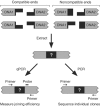
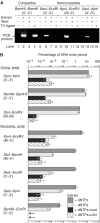


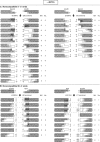
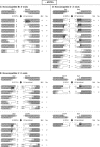
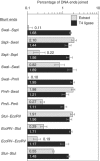
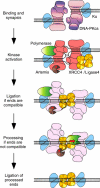
References
-
- Bebenek K, Garcia-Diaz M, Blanco L, Kunkel TA (2003) The frameshift infidelity of human DNA polymerase lambda. Implications for function. J Biol Chem 278: 34685–34690 - PubMed
-
- Boe SO, Sodroski J, Helland DE, Farnet CM (1995) DNA end-joining in extracts from human cells. Biochem Biophys Res Commun 215: 987–993 - PubMed
-
- Chan DW, Lees-Miller SP (1996) The DNA-dependent protein kinase is inactivated by autophosphorylation of the catalytic subunit. J Biol Chem 271: 8936–8941 - PubMed
Publication types
MeSH terms
Substances
Grants and funding
LinkOut - more resources
Full Text Sources
Other Literature Sources
Research Materials

